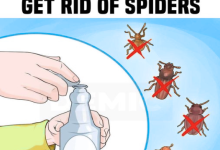Painters routinely use trade secrets to help them paint faster, smarter and neater without sacrificing quality. Here are the top 20 painting tips that probably you never knew before.
1. Sand Away Flaws

To apply a perfectly smooth coat of paint to walls, ceilings, and woodwork, you must start with a perfectly smooth surface. Sanding with the appropriate abrasive paper helps level out spackling compound and drywall joint compound patches, flattens ridges around nail holes, and feathers out repairs to inconspicuously blend into the surrounding surface. Sanding also removes burrs and rough spots in painted wood trim, such as baseboard moldings, and window and door casings. And roughing up a glossy painted surface with fine-grit sandpaper allows the new paint coat to adhere more easily.
Use a sanding pole fitted with 220-grit sandpaper to sand the walls vertically from the baseboard up to the ceiling. Be sure to overlap each stroke slightly to ensure you don’t miss any spots. Then sand horizontally along the top of the baseboard molding, and along the tops of the walls at the ceiling. Don’t apply too much pressure on the sanding pole or its swiveling head might flip over and damage the wall. Plus, sandpaper tends to load up (clog) when you press down too hard.
To sand decorative woodwork, try using a sanding sponge, which gets into crevices and easily conforms to contours.
2. Buy the Best Supplies

Don’t cheap out on paint and brushes. Cheap brushes are a false economy. Purchase the best brushes you can afford, clean them well, and they’ll last you a lifetime.
It’s also important to buy the best paint you can afford. It’ll go on easy, offer the best coverage, and last a long time. Plus, you’ll be able to wash off grubby fingerprints without taking off the paint. And the whole painting job will go quicker and easier, and look better in the end.
3. Cover Furniture

When painting a room, don’t bother lugging all the furniture out of the room. Instead, push all the furnishings to the center of the room and then cover them with plastic sheets that are taped at the bottom. This will protect the furniture from paint drips and splatters, and also from all the sanding dust.
4. Use Tinted Primer

Before the pros paint walls, they fill holes and patch cracks with joint compounds. But if you paint directly over the patched areas, the compound will suck the moisture out of the paint, giving it a flat, dull look; a problem called “flashing.” And those spots will look noticeably different than the rest of the wall. To avoid seeing patched areas through the finished top coat of paint, it’s important to first prime the walls.
However, instead of using a white primer straight from the can, pros tint the primer with a little gray paint or with the color of the finish paint. Tinted primer does a better job of concealing patched areas and covering up the old paint color. As a result, the finished paint coat will be more vibrant and may require fewer coats. This is especially true when painting over colors like red or orange, which could require three or more topcoat coats if you don’t first apply a tinted primer.
5. Press Tape With a Putty Knife

Painter’s tape is an indispensable part of every paint job, especially when masking off wood trim. But nothing is more discouraging than peeling off the tape only to discover that paint has bled through the tape and got all over trim. To avoid the pain-in-the-neck chore of scraping off the errant paint, do a thorough job of adhering to the tape before you start painting.
Apply the tape to the wood trim, then run a putty knife over the tape to firmly press it down for a good seal. That’ll stop any paint bleeds. And be sure to use true painter’s tape, not masking tape. Masking tape leaves behind a sticky residue that’s hard to clean off. Plus, paint can cause masking tape to buckle and wrinkle, which lets paint seep beneath it. Painter’s tape can be left on for days (some types up to two weeks) and still peel off cleanly.
6. Eliminate Brush and Lap Marks With Paint Extender

The telltale sign that a room has been painted by a novice DIYer, not a pro, is that there are visible lap marks in the finished paint coat. The secret to a finish that’s free of noticeable lap marks and brush strokes is mixing a paint extender (a.k.a.: paint conditioner), such as Floetrol, into the paint. This does two things: 1) It slows down the paint’s drying time, giving you more time to paint over just-painted areas without getting ugly lap marks, which happens when you apply fresh paint to dried paint. 2) Paint extender levels out the paint, virtually eliminating brushstrokes.
Pros use extenders when painting drywall, woodwork, cabinets, and doors. Read the can’s label to determine how much extender to add to your paint, but it’s typically 8 oz. of extender per one gallon of paint. If the paint is especially thick, or if you’re painting in very cold weather, more extender can be added, up to about 16 oz.
7. Scrape a Ridge in Textured Ceilings

When painting along the top of a wall in a room with a textured ceiling, it’s almost impossible not to get paint on the ceiling bumps. Pros have a simple solution: Run the tip of a slotted screwdriver around the perimeter of the ceiling, scraping off a little bit of the texture. The screwdriver creates a tiny ridge in the ceiling, which the tips of your paint bristles naturally go into it. Now, you can cut in around the ceiling without getting paint onto the ceiling. And you’ll never even notice the missing texture.
8. Use Canvas Drop Cloths

Professional painters don’t use old bedsheets as drop cloths, and neither should you. Thin sheets won’t stop splatters and spills from seeping through to your flooring. And don’t use plastic sheeting either. While plastic does contain spills, the paint stays wet for way too long time. And if you step in wet paint, you’ll end up tracking it throughout the house. Plus, wet paint on slick plastic becomes very slippery.
Use what the pros use—canvas drop cloths. They’re more expensive, but the canvas isn’t slippery, it absorbs splatters, and it’s durable enough to last a lifetime. And unless you’re painting a ceiling, you don’t need a jumbo-sized drop cloth to fill the entire room. A canvas cloth that’s just a few feet wide and runs the length of the wall is ideal for protecting the floor.
9. Finish One Wall Before Starting Another

Most DIY painters cut in all the room corners, and then go back and roll paint onto the walls, but that’s not the correct way to paint a room. Pros get a seamless look by cutting in one wall, and then immediately rolling on the paint before the cut-in sections dry. This allows the brushed and the rolled sections to blend together beautifully.
Also, cover your paint bucket, tray, or container with a damp towel when switching between brushing and rolling; that’ll keep your paint and tools from drying out when not in use.
10. Scrape (Don’t Tape) Windows

When painting windows, don’t bother taping around the window frame and grill. That takes a too long time and paint usually ends up on the glass anyway. Try this pro trick instead: As you paint the window, let a little paint lap onto the glass. Once it’s dry, simply scrape it off with a razor scraper. Just be careful not to slice through the paint bond between the wood and glass. Otherwise, moisture can seep into the wood and cause rot.
11. Box Paint for Consistent Color

When you buy two or more cans of the same color paint, guess what? They’re almost never the same exact color. That’s because paint color varies very slightly between cans. And that small difference can be glaringly obvious if you open a new gallon halfway through a wall.
To ensure color consistency from start to finish, pros mix their cans of paint into a five-gallon bucket, a technique known as “boxing” paint. Then you can paint directly out of the larger bucket, which eliminates the need to pour paint into a roller tray.
Some pros then paint directly out of the bucket. This eliminates the need to pour paint into a roller tray, though the heavy bucket is harder to move.
12. Wash Roller Covers

Odd as it may sound, it’s important to wash brand-new paint-roller covers before using them to spread paint. Pre-washing gets rid of loose bits of fuzz that inevitably come off once you start painting. Wash the covers with water and a little bit of liquid soap, then run your hands up and down the covers to pull off any loose fibers, a practice called preconditioning. And you can start using the roller covers right away; you don’t have to wait for them to dry.
13. Start With a Loaded Brush

Pros take a “load and go” approach to painting. They load the bottom 1½ in. of their brush bristles with paint and then tap each side of the brush against the inside of the can. That knocks off heavy drips and prepares the brush for painting. By contrast, homeowners often take a “load and dump” approach: They dip the brush into the paint, then drag the loaded bristles along the sides of the container, wiping off most of the paint. The result is a brush that’s too dry and has too little paint.
14. Push Paint to Avoid Runs

When your brush is loaded with paint, it’s easy to create drips and runs by applying too much paint in room corners or along with wood trim. To avoid those issues, start brushing about a 1/2 inch away from the cut-in area. As the brush unloads paint, move closer and slowly drag the brush along the trim or corner. Let the bristles gently push the paint against the cut-in area where the walls meet. You may have to do this a couple of times to get complete coverage, but it’ll avoid excess paint collecting along with woodwork and in corners.
15. Bag It Up

When you’re ready to quit for the day but haven’t finished painting, leave the roller cover on the roller frame, then soak the cover in paint. Wrap the cover in a plastic bag to create an airtight seal. That’ll keep the roller cover fresh until you return to painting the next day. If you can’t return to painting for several days, pull the roller cover off the frame and toss it out. Then use a new roller cover the next time.
As for your brushes, rinse them clean with warm, soapy water, if using latex paint, which is water-based. Use paint thinner to clean off oil-based paint. Then rake the bristles out straight with a brush comb and then slip the brushes back into their original covers or wrap them in a newspaper.







